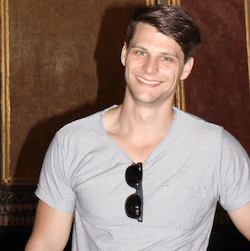My recent Journal of Pain article (Niederstrasser et al., 2015) can be summarised in one really long, cryptic and almost unintelligible sentence, which if you bear with me, I will explain:
“If you have high levels of catastrophic thinking about pain and high fear of pain, and we inflict pain on one part of your body, then you are more likely to experience increasing levels of pain during movements of another part of your body, which should not be painful in the first place”.
To illustrate this point, consider a fictitious example. Imagine I have just moved house and I am painting the walls of my new home. Moving the brush up, down, and along the walls spreading the paint may be cumbersome and tiring, but rarely painful for a healthy adult. I may not be ambidextrous, but I can manage to move the brush with either hand virtually pain free. Imagine now, I climb a ladder to paint the ceiling, fall off, and break my right arm. A day later I return to my new home and want to continue painting. As I am a man of habit, I pick up the brush with my right hand and attempt to finish the ceiling. What ensues is pure agony; I can assure you, painting with a broken arm is no picnic. The sensible thing to do then is to use my ‘good’ injury-free left arm for painting instead. As I pick up the paint brush with my left arm and continue painting I start noticing that it is a lot harder than yesterday and actually becomes painful. It gets to the point where I cannot bear to continue. In confused agony I sit down and ask myself: why does my left arm suddenly hurt after I broke my right arm?
It sounds counterintuitive that painting with your left arm becomes painful if you break your right arm. However, we have to move away from the idea that pain is proportional to or even dependent on tissue damage. How we think about pain is a powerful predictor of how we experience pain. Pain catastrophising and fear of pain are two of the most-widely researched variables in that context. Pain catastrophising refers to a negative cognitive-affective response to actual or anticipated pain. As part of this ‘negative cognitive-affective response’ people are thought to interpret pain as exceptionally menacing and feel helpless in the face of pain. Fear of pain refers to the fear that emerges when the individual perceives stimuli related to pain (e.g. movements or postures) as a threat. It is commonly accepted that pain catastrophising and fear of pain can exacerbate the experience of painful stimulation, but in the fictitious example above, and in our experiment, a previously non-painful stimulus became painful. Now, don’t worry, we did not break anybody’s arm in the name of science and have them paint our ceiling. We used ‘delayed-onset muscle soreness’, which is essentially the stiffness and discomfort you experience in your muscles following a bout of unaccustomed exercise, to mimic musculoskeletal injury. We had participants perform strength exercises with one arm to induce this soreness, and left the other arm untouched.
Following the DOMS-induction the non-noxious stimulus (e.g. painting with injury-free arm) became increasingly painful over repeated stimulations for individuals scoring high on pain catastrophizing and high on pain-related fear. In other words, there was a significant increase in pain in response to a non-noxious stimulus over time, after musculoskeletal injury had been induced in the opposite body side. The findings thereby demonstrated increased pain to the same non-noxious stimulus (e.g. painting), as well as the occurrence of pain in an anatomically distinct region of the body, only after injury had been induced in a distal site of the body.
Why might pain occur in my injury-free arm while painting? One could argue that breaking my right arm brought about an increased pain sensitivity which spread throughout my body. Pain can influence the central nervous system and lower the threshold for a sensation to be processed as painful. This means that you feel more pain to less provocation. In other words, as a result of breaking my arm, the sensitivity of the pain-relevant neurons in my CNS increased, making me more sensitive not only to things that should hurt (painting with my broken arm), but also to ordinary touch and pressure (injury-free arm).
Alternatively, learning processes such as generalisation may be responsible. Generalisation implies that once I broke my right arm, I started associating painting with that arm with pain. The similarity between the movements of painting with my right and left arms led to a transfer of the expectation of pain from the right (injured) to the left (injury-free) arm. Merely expecting (more) pain might aggravate even non-noxious stimulation, such that it becomes painful, which left me in pain when painting my ceiling with my left arm, in the absence of tissue-damage.
Our findings suggest that the way you think about pain (the extent to which you catastrophise about and fear pain), may promote generalisation and/or sensitisation processes, but at this stage of the investigation this cannot be said with absolute certainty.
About Nils Niederstrasser
 Nils is a PhD student under the supervision of Prof. Johan Vlaeyen in the research group on Health Psychology in the department of Psychology and Educational Sciences at KU Leuven, Belgium. The first two years of his PhD Nils spent in Montreal working with Prof. Michael Sullivan on a number of projects examining the influence of psychological factors on the spreading of pain. His current research focuses on generalization processes in the development of chronic pain. He is due to defend his PhD in December 2015.
Nils is a PhD student under the supervision of Prof. Johan Vlaeyen in the research group on Health Psychology in the department of Psychology and Educational Sciences at KU Leuven, Belgium. The first two years of his PhD Nils spent in Montreal working with Prof. Michael Sullivan on a number of projects examining the influence of psychological factors on the spreading of pain. His current research focuses on generalization processes in the development of chronic pain. He is due to defend his PhD in December 2015.
References
Niederstrasser, N. G., Meulders, A., Meulders, M., Slepian, P. M., Vlaeyen, J. W., & Sullivan, M. J. (2015). Pain Catastrophizing and Fear of Pain Predict the Experience of Pain in Body Parts Not Targeted by a Delayed-Onset Muscle Soreness Procedure. J Pain, 16(11), 1065-1076. doi:10.1016/j.jpain.2015.07.008



